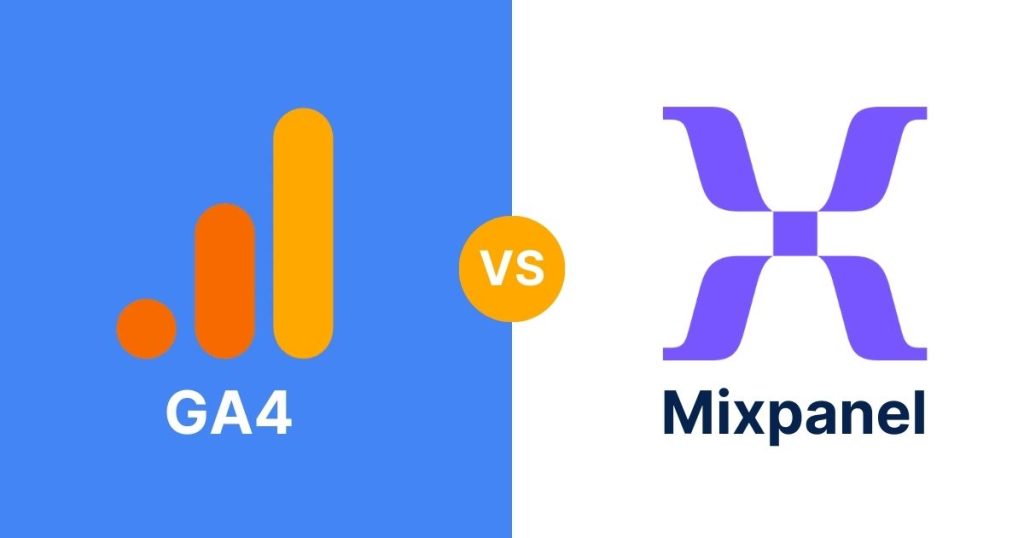These days, knowing your audience well is more important than ever. Analytics tools come into play here, helping to reveal what users do, what they like, and the latest trends. Analytics is more than just looking at numbers, it’s about finding useful information that helps you make smarter choices and plans for your business.
Among all the different tools out there, GA4 (Google Analytics 4) and Mixpanel really stand out. GA4, the newest version from Google, is famous for its thorough tracking features and how well it works with other Google products. Meanwhile, Mixpanel is all about understanding how users interact with your site or app, giving you detailed information on this.
In this blog, we’re going to compare GA4 vs Mixpanel closely. Our goal is simple: to help you understand the strengths and weaknesses of each tool, so you can pick the one that fits your business the best. Whether you run a small business, work in digital marketing, or are just interested in analytics, this comparison is meant to give you clear and useful information. Let’s take a look at these tools and discover how they can brighten your online business path.
We’re not just here to talk about GA4 and Mixpanel, we can also help you use them. Our team works with these tools every day, so we know them inside out.
If you need a hand or have questions about using GA4 or Mixpanel for your business, feel free to contact us. Visit us at Goodish Agency – Google Analytics 4 for more information and to reach out to us. Let’s make your data work for you!
Background GA4 vs Mixpanel
GA4
Google Analytics has been a top choice for website analysis since it started in 2005. It has changed a lot over time. Google Analytics 4 is the newest version, made to take over from the older Universal Analytics. This update came about because there was a need for an analytics tool that was more focused on the user, cared about privacy, and could easily work with both website and app data.
Its main features are better tracking of how users interact across different platforms, using machine learning in a smarter way to give useful information, and giving you more ways to protect user data.
It is meant to provide a fuller understanding of how users interact with your website or app. It’s commonly used for keeping an eye on user behavior and how well websites perform, as well as figuring out if marketing efforts are working.
Mixpanel
Mixpanel began in 2009, concentrating on event tracking – which means understanding how users interact with websites and apps. It became well-known for its thorough way of tracking what users do, not just looking at page views.
Mixpanel’s key features are a thorough look at user actions, the option to group users based on how they act, and tools for sending specific messages and doing A/B testing. This makes Mixpanel very handy for businesses that want to get better at engaging users, try out new features, and make user experiences more personal.
User Interface and Ease of Use
When it comes to the user interfaces of GA4 and Mixpanel, there are some noticeable differences that can affect how easy they are to use, especially for beginners.
GA4
GA4’s interface is quite clean and organized, but it can be a bit overwhelming for new users. This is mainly because it packs a lot of features and data into its dashboard. For someone just starting out, figuring out where everything is and how to use it effectively might take some time.
However, once you get the hang of it, it becomes a powerful tool. It offers customizable dashboards and reports, which are great for seeing the data that matters most to you. The challenge is in the initial learning phase.
Mixpanel
Mixpanel, on the other hand, has a more straightforward and user-friendly interface. It’s designed to make it easier for users to find what they need quickly. The layout is intuitive, which is great for beginners. New users can start tracking events and analyzing data right away. It also provides clear visualizations, making it simpler to understand the data at a glance.
Feature
- Learning Curve
- User-Friendly Features
Navigation Complexity
GA4
- More challenging, needs time to learn
- Advanced (machine learning, segmentation)
- Less intuitive at first
Mixpanel
- Beginner-friendly, easy to start
- Simple (clear tracking, visualizations)
- Straightforward and easy
Data Tracking and Management
Understanding how GA4 and Mixpanel track and manage data is key to figuring out which tool is right for your needs. Let’s break down how each platform handles data tracking and management.
GA4
Data Tracking
Event Tracking: GA4 focuses heavily on events. Almost every interaction on your website or app is considered an event, like page views, button clicks, or user actions.
User Interactions: It tracks users across devices and platforms, giving a combined view of how users interact with your content.
Data Management
Import/Export Features: It allows you to import data from other Google services and export data to tools like Google BigQuery for advanced analysis.
Flexibility: It offers more flexibility in data collection and reporting, letting you customize data to fit your specific needs.
Mixpanel
Data Tracking
Event Tracking: Mixpanel is also event-driven but provides a more granular look at user actions. It lets you track specific events to understand user behavior in detail.
User Interactions: It excels in tracking individual user journeys and creating detailed user profiles based on their interactions.
Data Management
Import/Export Features: It supports data import and export, but its strength lies in real-time data analysis rather than extensive data exporting.
User Segmentation: A standout feature is its ability to segment users based on their actions, which is great for targeted marketing and user experience optimization.
Feature
- Event Tracking
- User Interactions
- Data Import/Export
- Flexibility
GA4
- Tracks all user interactions
- Across devices
- Good for import/export
- Customizable
Mixpanel
- Detailed event analysis
- Individual user focus
- Better for real-time analysis
- Strong in user segmentation
Integration Capabilities
Both GA4 and Mixpanel offer integration with various other tools and systems, which is crucial for streamlining your data analysis and marketing efforts. Let’s look at what each platform offers in terms of integrations and how easy it is to integrate them with other systems.
GA4
Available Integrations
Google Products: Integrates seamlessly with other Google products like Google Ads, Google Search Console, and Google Data Studio.
CRM Systems: Can be integrated with some CRM systems, enhancing customer data analysis.
Marketing Tools: Works well with various marketing platforms, allowing for better campaign tracking and analysis.
Ease of Integration and Limitations
Ease of Integration: Integrating GA4 with other Google products is straightforward, but integrating with non-Google products can sometimes be more complex.
Limitations: While GA4 offers a wide range of integrations, the depth of integration with non-Google tools may not be as extensive as with Google’s own products.
Mixpanel
Available Integrations
CRM Systems: Mixpanel offers integrations with popular CRM systems, aiding in detailed customer analysis.
Marketing Tools: It also integrates with various marketing tools, helping in targeted campaigns and user engagement tracking.
Other Tools: Includes integrations with communication tools, data warehouses, and more.
Ease of Integration and Limitations
Ease of Integration: Mixpanel is generally user-friendly when it comes to integration with other tools, often requiring minimal technical knowledge.
Limitations: The main limitation with Mixpanel is that it might not integrate as deeply with Google products compared to GA4.
Feature
- Google Products
- CRM Systems
- Marketing Tools
- Other Tools
- Integration Ease
- Limitations
GA4
- Seamless integration
- Some integration
- Good integration
- -
- Varied
- Better with Google
Mixpanel
- Limited integration
- Good integration
- Good integration
- Communication, data warehouses, etc.
- User-friendly
- Better without Google
Customization and Flexibility
When choosing between GA4 and Mixpanel, it’s important to consider how much you can customize each tool and how flexible they are for different business needs. Let’s break down what each platform offers in terms of customization and flexibility.
GA4
Customization
Custom Dashboards and Reports: GA4 allows you to create custom dashboards and reports. This means you can set up your analytics view to focus on the data that matters most to your business.
Custom Events and Metrics: You can also define custom events and metrics, giving you the freedom to track specific activities that are unique to your business.
Flexibility
Adapting to Business Needs: GA4 is quite flexible and can be adapted to various business sizes and types. Whether you’re a small startup or a large enterprise, GA4 can be customized to meet your specific needs.
Integration Flexibility: With its strong integration capabilities, especially with other Google products it can fit into many different digital ecosystems.
Mixpanel
Customization
Custom Reports: Mixpanel excels in offering highly customizable reports. You can take a look at user behavior and customize reports to highlight the insights you need.
Event and User Segmentation: It allows for detailed segmentation of events and users, which is great for businesses focused on understanding and improving user engagement.
Flexibility
Business Adaptability: It is also flexible and can be used by businesses of all sizes. It’s particularly good for companies that need detailed insights into user behavior.
Integration with Various Tools: While it may not integrate as deeply with Google products as GA4, Mixpanel works well with a wide range of other tools, making it adaptable to different business setups.
Feature
- Customization
- Flexibility
- Business Size Suitability
- Integration
GA4
- High
- Google-centric
- All sizes
- Strong with Google
Mixpanel
- User behavior-focused
- Broad
- All sizes
- Wide range
Real-time Data and Reporting
In these times any business can benefit from real-time data and flexible reporting options. Let’s take a look at how GA4 and Mixpanel handle these, focusing on their capabilities and the types of reports they offer.
GA4
Real-time Data
Capabilities: GA4 provides real-time data that shows what’s happening on your website or app at any given moment. This includes user actions, active pages, and geographic locations of users.
Usefulness: This is particularly useful for monitoring immediate effects of marketing campaigns or website changes.
Reporting Features
Report Types: GA4 offers a variety of report types, including user acquisition, audience demographics, and behavior reports.
Customization: These reports are highly customizable, allowing you to tailor them to your specific business needs. You can create your own reports from scratch or modify existing templates.
Mixpanel
Real-time Data
Capabilities: Like GA4, Mixpanel provides real-time data, giving insights into how users are interacting with your site or app instantly.
Detail Level: Mixpanel’s real-time data is detailed, focusing on individual user actions and journeys.
Reporting Features
Report Types: It specializes in event-based reports, user journey analysis, and funnel reports.
Customization: It offers extensive customization options for reports, enabling you to drill down into very specific user behaviors and segments.
Feature
- Real-time Data
- Report Types
- Customization
GA4
- Anonymizes user data
- Diverse (acquisition, demographics, behavior)
- Highly customizable reports
Mixpanel
- Detailed individual user actions
- Focused (event-based, user journey)
- Extensive customization for user behavior
Privacy and Data Security
In a world where data privacy is increasingly important, it’s essential to know how tools like GA4 and Mixpanel handle user data and comply with privacy laws like GDPR and CCPA. Let’s explore their approaches to privacy and data security.
GA4
Compliance with Privacy Laws
GDPR and CCPA: GA4 is designed to comply with major data privacy laws like GDPR in Europe and CCPA in California. It offers features to manage data collection and user consent.
Anonymization: GA4 provides options to anonymize IP addresses and manage data retention, helping to protect user privacy.
Security Features
Data Encryption: GA4 ensures that data is encrypted both in transit and at rest, adding an extra layer of security.
Access Controls: It allows you to set different access levels for users, ensuring that only authorized personnel can view sensitive data.
Mixpanel
Compliance with Privacy Laws
GDPR and CCPA: Mixpanel also adheres to GDPR and CCPA regulations. It includes tools for managing user consent and data deletion requests.
User Data Control: Mixpanel gives users control over their data, allowing them to opt-out of tracking if they wish.
Security Features
Data Security: Mixpanel places a strong emphasis on data security, using encryption and secure data storage practices.
Custom Data Retention: You can customize data retention settings, deciding how long to keep user data.
Feature
- Privacy Law Compliance
- User Data Management
- Data Encryption
- Access/Data Retention
GA4
- GDPR, CCPA
- Anonymization, consent tools
- Yes
- Controlled access
Mixpanel
- GDPR, CCPA
- Opt-out options, deletion tools
- Yes
- Custom retention
Pricing and Plans
Choosing the right analytics tool also means considering how much it costs and what you get for your money. Let’s compare the pricing structures of GA4 and Mixpanel, focusing on their features, scalability, and how well they fit businesses of different sizes.
GA4
Pricing Structure
Free Version: GA4 offers a robust free version, which is often enough for small to medium-sized businesses.
Paid Version: For larger businesses or those needing advanced features, GA4 integrates with Google’s BigQuery, which may incur additional costs.
Features and Scalability
Free Version Features: The free version includes comprehensive analytics tools suitable for most businesses.
Scalability: GA4 scales well with your business growth, especially when integrated with other Google services.
Suitability
Business Size: GA4 is suitable for all sizes, from small startups to large enterprises.
Mixpanel
Pricing Structure
Free and Paid Versions: Mixpanel offers a free version with basic features and several paid plans that increase in price based on the number of tracked users and features.
Custom Plans: For very large businesses, Mixpanel offers custom plans customized to specific needs.
Features and Scalability
Free Version Features: The free version is limited but useful for small businesses or startups.
Scalability: Paid plans offer more detailed analytics and are designed to scale with your business.
Suitability
Business Size: Mixpanel is great for businesses of all sizes, but the cost can be higher for larger businesses due to its pricing model based on user tracking.
Feature
Pricing Structure- Free Version
- Scalability
- Suitability
GA4
- Free version; Paid for advanced integration
- Comprehensive for most needs
- Good for all business sizes
- Fits all sizes, best for Google-integrated businesses
Mixpanel
- Free and paid plans based on usage
- Basic, suitable for small businesses
- Scales with business, can get costly
- Good for all sizes, price varies with usage
Metrics Comparison
User Acquisition
User Acquisition Metrics help you see which channels, like search engines or social media, are bringing people to your website or app. This information is important for figuring out what parts of your marketing are working best. Here we’ll look at how GA4 and Mixpanel handle these metrics, showing what each tool does differently and the useful things you can learn from them.
GA4
GA4’s User Acquisition Metrics show how users find your site through various channels, such as organic search and social media, while tracking their behavior and conversions.
Unlike Mixpanel, GA4 lacks a dedicated funnel visualization for user acquisition details, making Mixpanel better suited for tracking specific user journeys and conversion drop-offs.
Mixpanel
Mixpanel’s User Acquisition Metrics, found in the ‘Funnels’ section, excel at tracking user journeys and detailed event-based interactions within your site or app.
It’s great for understanding individual user behavior and funnel drop-offs. GA4, while providing user acquisition data, doesn’t offer the same level of detailed tracking as Mixpanel in this regard.
User Engagement
User Engagement Metrics are vital for understanding how effectively your website or app engages your audience. These metrics provide insights into user interactions, content consumption, and overall user satisfaction.
In this section, we’ll explore how GA4 and Mixpanel handle User Engagement Metrics, highlighting their respective strengths and capabilities.
GA4
In GA4’s ‘Engagement’ reports, you can monitor Session Duration, Pages per Session, and Engagement Rate.
These metrics offer insights into user interactions and retention on your site or app.
Additionally, you can analyze specific user events for more detailed insights.
Mixpanel
In Mixpanel’s ‘Engage’ and ‘Retention’ reports, you can access detailed insights on user actions.
These reports allow you to track and analyze specific user behaviors, such as button clicks, feature usage, or any custom events you’ve defined.
Additionally, Mixpanel provides information on user retention over time.
Event Tracking
Event Tracking plays a vital role in analytics, allowing businesses to closely monitor and gain insights into user interactions with their digital platforms. In this section, we’ll explore how GA4 and Mixpanel approach event tracking, showcasing their unique features and functionalities.
GA4
In GA4’s ‘Events’ section, you can customize event tracking to monitor user interactions like clicks and downloads on your website or app. While it offers flexibility in defining custom events, it may not provide the same level of granularity as Mixpanel.
Mixpanel
In Mixpanel, event tracking is accessible through the ‘Events’ tab and offers a more granular level of tracking for user actions. This means you can closely monitor specific events, such as button clicks, form submissions, or any custom interactions you define, providing detailed insights into user behavior.
Conversion Rates
In this section, we’ll explore how GA4 and Mixpanel help you understand how effectively users are completing desired actions on your website or app. Let’s dive into conversion rates and what insights these tools offer about user behavior.
GA4
In GA4, conversion tracking is centered around the goals you set. These goals can be page views, specific events, or user interactions that you define as valuable.
You have the flexibility to customize what constitutes a conversion. This could be a completed transaction, a form submission, or any other action that aligns with your objectives.
Mixpanel
The Retention section in Mixpanel tracks how often users return and engage with your site or app after a conversion event.
It typically presents data in a cohort analysis format, showing the percentage of users returning over specific time intervals post-conversion.
Demographic Information
Here, we’ll compare how GA4 and Mixpanel track user demographics, crucial for shaping your content and marketing efforts. We’ll look at the ways each tool approaches gathering and presenting demographic data on your website or app.
GA4
In GA4, the “User attributes overview” section provides key demographic information, including age, gender, geographical location (country and region), and language preferences of your users.
This section also offers insights into users’ interests, which can be invaluable for content and marketing strategy.
Additionally, it includes data on the devices and technology used by your audience, offering a broader understanding of user behavior and preferences.
Mixpanel
In Mixpanel’s ‘Users’, you can view detailed information by clicking on individual profiles.
Each profile shows demographic details like age and gender, along with user-specific behaviors such as how they interact with your site or app.
This per-user view allows for an in-depth understanding of each user’s unique behaviors and preferences.
Conclusion
To sum up, GA4 and Mixpanel each have their own benefits. GA4 is great if you use a lot of Google products and need a broad view of your analytics. Mixpanel is better for detailed insights into how users interact with your site or app and is easier to use.
The best choice depends on what your business needs, how big it is, and how detailed you want your data to be. Whether you go for GA4’s wide range and scalability or Mixpanel’s focus on user behavior, both tools are powerful for understanding and improving your online business.
We hope this comparison helps you decide which tool is right for you. If you have more questions or need help with these tools, don’t hesitate to get in touch for more advice.
We at Goodish agency are experts in digital marketing and we can help you to utilize AI to reduce your costs and boost your performance. Read more about our services.











